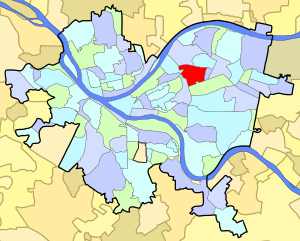Bloomfield (Pittsburgh)
| Bloomfield | |
|---|---|
| Neighborhood of Pittsburgh | |

View of Liberty Avenue in Bloomfield.
|
|
 |
|
| Coordinates: 40°27′40″N 79°56′53″W / 40.461°N 79.948°W | |
| Country | United States |
| State | Pennsylvania |
| County | Allegheny County |
| City | Pittsburgh |
| Area | |
| • Total | 0.702 sq mi (1.82 km2) |
| Population (2010) | |
| • Total | 8,442 |
| • Density | 12,000/sq mi (4,600/km2) |
Bloomfield is a neighborhood in Pittsburgh, Pennsylvania. It is located three miles from the downtown area. Bloomfield is sometimes referred to as Pittsburgh's Little Italy because it was settled by Italians from the Abruzzi region and has been a center of Italian-American population. Pittsburgh architectural historian, Franklin Toker, has said that Bloomfield "is a feast, as rich to the eyes as the homemade tortellini and cannoli in its shop windows are to the stomach." Today neighborhood residents include working-class Italian-Americans, various other European-descended populations, African Americans, and a substantial population of college students. It has attracted young adults as a "hip" neighborhood.
Liberty Avenue is the neighborhood's main business thoroughfare. Every year Bloomfield hosts Little Italy Days, a large festival celebrating the neighborhood's rich Italian history.
Bloomfield is a plateau above the Allegheny River; it is bordered by Penn Avenue on the north, the East Busway on the south, 40th Street on the west, and Gross Street on the east. This last boundary is somewhat disputed – many residents believe that Bloomfield abuts the neighborhood of Friendship at Gross Street. Here the provincial frame rowhouses give way to stand-alone brick Victorian homes, which were built larger on each street heading east. The City of Pittsburgh, however, claims that Bloomfield extends east as far as Graham Street.
The East Busway is set into an existing valley that separates Bloomfield from Polish Hill to the west, the Hill District to the southwest, and Shadyside to the south. The neighborhoods are within sight of one another, and are connected by the Bloomfield Bridge and the South Millvale Bridge, both of which span this gap.
Bloomfield does not appear to have been an independent borough prior to its annexation by the City of Pittsburgh in 1868. The land here was claimed from the native Delaware tribe by Casper Taub, one of the area's earliest European settlers. Taub sold the land to his son-in-law John Conrad Winebiddle, whose descendants divided it into lots and sold it for development beginning around the time of the 1868 annexation. The community most likely was named for the abundant blooming flowers near the original town site.
...
Wikipedia
